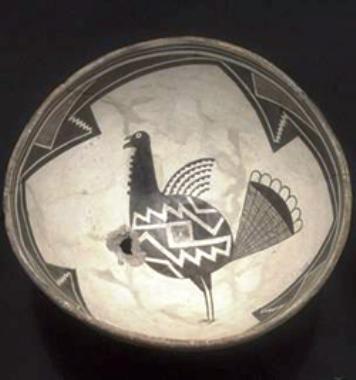Turkeys Part I: The reason why cranberry jelly was invented
Mjs 76
Source : http://www2.le.ac.uk/news/blog/2010-archive/december/turkeys
On 25 December when you’re tucking into a slice of hot roast turkey*, spare a thought for the history of this noble bird. Native to North America, imported to Europe, re-imported to America, it has been a status symbol, even a god – and now it’s lying on your plate next to some roast parsnips.
The extraordinary story of the turkey is the focus of Brooklynne Fothergill’s ongoing PhD study, a project which is at one and the same time very specific and impressively broad. Based in our School of Archaeology and Ancient History, her research centres on paleopathology (the study of disease through ancient remains) but incorporates ancient and medieval history, archaeology, biology, veterinary science, cultural studies and, of course, gastronomy.
Few people can talk turkey quite like Brooklynne. In this three-part festive Newsblog special, we will use some of her research to explore the history and mystery of the bird they call Meleagris gallopavo.
Wild turkeys occur right across North America from central Mexico as far north as the Canadian border; they were first domesticated by Meso-American people somewhere around 500AD. While we think of the bird primarily as a food source, there is a theory (which Brooklynne’s research supports) that their primary role was initially as a source of feathers.

Mimbres bowl, c.1000-1200 (image: Amerind Foundation)
Turkeys are large birds with extensive body covering, large primaries on their wings (wild birds are quite capable of flight) and, in males, a magnificent fan of tail feathers. For a society without cotton, a ready supply of large, soft, hard-wearing feathers was of great benefit in the creation of clothing, blankets and ceremonial artefacts. Turkeys can actually be plucked while alive (if you’re strong enough!) and will regrow their feathers, making the process analogous to shearing sheep. And just like sheep, meat production (where it occurred) was probably a secondary purpose of domestication.
Interestingly, turkeys have rarely been used to provide eggs. You can certainly eat turkey eggs; you can eat pretty much any egg, it’s just a protein soup with its own convenient cup. But turkeys simply don’t produce eggs at the rate that chickens or ducks do and consequently they’ve never really been bred in that direction, being selected instead for fine feathers and plump, meaty breasts.

Chalchiuhtotolin, Aztec turkey god (image: Wikipedia)
The religious and ceremonial significance of the bird is evident in some of the buried remains which have been found at pre-Columbian sites: whole turkey skeletons, headless turkeys, even turkeys buried alongside humans. A turkey skeleton has been found on an altar in Oaxaca. There was even a hard-to-pronounce Aztec turkey god, Chalchiuhtotolin, associated with disease and plague.
Then along came the Spanish…
European explorers, after weeks at sea, have always judged every newly encountered creature on three criteria: how easy is it to catch? how fat is it? and what does it taste like? (cf. the dodo, Steller’s sea cow etc.) To the Conquistadors, the turkey was an obvious source of meat and they were perplexed to see so many half-plucked birds wandering around, while the natives were equally puzzled why anyone would want to eat a turkey with years of feather-production still in it.
“For my own part I wish the Bald Eagle had not been chosen the Representative of our Country. He is a Bird of bad moral character. … For in Truth the Turkey is in Comparison a much more respectable Bird, and withal a true original Native of America... He is besides, though a little vain & silly, a Bird of Courage, and would not hesitate to attack a Grenadier of the British Guards who should presume to invade his Farm Yard with a red Coat on.”
Benjamin Franklin, letter to his daughter, 1784
In 1519 Montezuma’s gifts to Cortes included no fewer than 1,500 turkeys. However as the Aztec leader’s household got through 300,000 turkeys every year, this must have been barely noticeable.
As a fat, relatively sedentary animal that could be kept in an enclosed area eating whatever rubbish it’s given, turkeys were eminently suitable for keeping on board ships. (Actually their principal food is insects and there is some evidence that Meso-American people used them as a sort of walking pesticide, wandering among crops but eating only the bugs.) It wouldn’t be too long before one of them made it all the way across the Atlantic without being cooked…
suite : part.2.